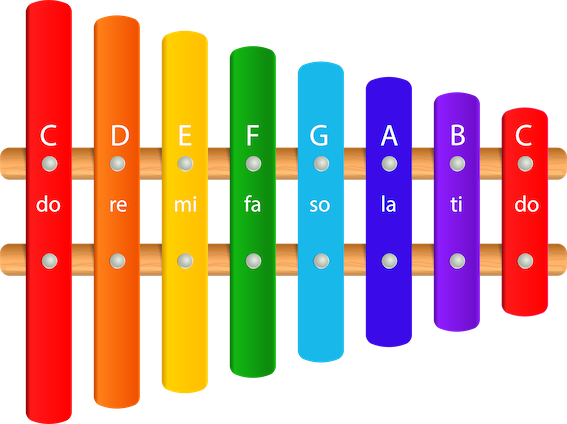Y4. Lesson 7. Practise Fa
Prior learning: None
Duration: 30 minutes
Materials: Woodblocks or claves
Keywords: Beat, rhythm, singing, chanting, partners, rhymes, circle games.
Difficulty: ![]()
Prepare
Present
Practise
Fa
 Melodic development
Melodic development
![]() Students discover fa in the do pentachord scale.
Students discover fa in the do pentachord scale.
To keep the fun in the lesson project the Melody Street graphic, showing fa.
- Lead the class in singing the first five pitches of the F major scale. Use solfa, but transitioning to traditional note names is good practice over time.
- Remind students of the concept of a scale and that they have already discovered the do pentatonic scale and the la pentatonic scale. Teach that a scale is an ordered series of notes.
- Teach that the first five notes starting on do is a new scale called the major pentachord.
- The pattern between the notes, stating on do is whole step, whole step, half step, whole step. This can be shown in the following way: d-r-m-f-s.
- Teach that these five notes can be numbered from 1 -5, with do being 1, re being 2 and so forth.
 Rhythmic development
Rhythmic development
![]() Students use tuned percussion to respond to teacher-led rhythms.
Students use tuned percussion to respond to teacher-led rhythms.

- Distribute tuned percussion instruments to the class.
- Begin by clapping a specific rhythm, such as ti-ti, ti-ti, ta, ta, for the students to copy.
- Transition to vocalising the rhythm using the pitch names of the notes, for example, C-C, C-C, G, G.
- Demonstrate the rhythm on your instrument and sing the pattern.
- Start slowly and articulate each note you want students to play to help them synchronise.
- Continue to call out the notes as the students play together to maintain timing.
- Expand the exercise by introducing various rhythms and pitches. Rotate students between instruments as needed to ensure everyone can participate.
 Game
Game
![]() Students have fun pretending to row with a call-and-response game.
Students have fun pretending to row with a call-and-response game.

- Lead the class in singing Michael Row The Boat Ashore.
- Students pretend to sit in boats (3 or 4 students to a boat, sitting one behind the other with legs crossed).
- Distribute the oars (rhythm sticks). Each student gets two oars.
- Tell the class they will perform one movement for the call and another for the response. Students will row during the call
- Demonstrate the movement for the call, rowing one stroke per measure.
- Students perform the rowing movement for the call each time it is heard.
- Demonstrate the movement for the response. Tap the rhythm sticks over your head at the beginning of each measure and then lower them to your side.
- Students perform the song again with the movement to the response.
 Listening
Listening
![]() Students listen and repeat back melodic intervals, including fa.
Students listen and repeat back melodic intervals, including fa.
- Students are seated.
- Play the first track on the audio player and sing the notes to the class in solfa and use hand signs.
- Ask how many notes you sang.
- Students should sing back the pattern in solfa and use hand signs.
- Remind students of the new note, fa.
 Visual learning
Visual learning
![]() Students discover where fa is found on a piano keyboard.
Students discover where fa is found on a piano keyboard.
- Project the graphic.
- If your learning environment has a piano, ask students to gather around it. If not, a tuned percussion instrument, such as a glockenspiel or xylophone, will work perfectly.
- With do starting on F ask students to find fa. Remind students of the pattern of notes in the do pentachord, which is whole step, whole step, half step, whole step.
- Ask where fa is found when do starts on C.
- Play and sing the five notes of the major pentachord, starting with F and then with C.
- Ask the class to listen and sing them back to you.
 Instruments
Instruments
![]() Students
Students
 Part work
Part work
![]() Students sing a four-part canon.
Students sing a four-part canon.
- Divide the class into three or four groups.
- Lead the class in singing Ah Poor Bird. This is a short but beautiful song perfect for a multi-part canon.
- When secure, teach each group to sing one measure after the previous one.
- Conduct in the first group and sing the first measure with them.
- The second group will begin on measure two, and the third group will begin on measure three.
- If the class is capable, add a fourth group to sing on the fourth measure.
- The audio player demonstrates how this would sound in an ideal environment!
 Assess
Assess
Suggested lessons
Y1. Beat II

Y1. Beat III

Y1. Beat IV

